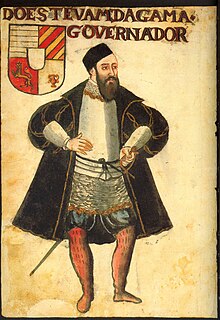Estêvão da Gama (16th century)
Estêvão da Gama | |
|---|---|
 Portrait of Estêvão da Gama in Livro de Lisuarte de Abreu, c. 1560. | |
| Governor of Portuguese India | |
| In office 1540–1542 | |
| Monarch | John III of Portugal |
| Preceded by | Garcia de Noronha |
| Succeeded by | Martim Afonso de Sousa |
| Personal details | |
| Born | 1505 Kingdom of Portugal |
| Died | 1576 (age 71–72) Lisbon, Kingdom of Portugal |
| Military service | |
| Allegiance | Portuguese Empire |
| Battles/wars | Ottoman–Portuguese conflicts (1538–1557) |

Estêvão da Gama (c. 1505–1576) was the Portuguese governor of Portuguese Gold Coast (1529–1535) and Portuguese India (1540–1542). Named after his paternal grandfather Estêvão da Gama, Estêvão was the second son of Vasco da Gama, and the brother of Cristóvão da Gama.
He commanded the fleet that entered the Red Sea, with the intent of attacking the Ottoman fleet in its harbor at Suez, leaving Goa on 31 December 1540 and reaching Aden on 27 January 1541. The fleet reached Massawa on 12 February, where Gama left a number of ships and continued north. Reaching Suez, he discovered that the Ottomans had long had intelligence of his raid, and foiled his attempt to burn their beached ships. Gama was forced to retrace his steps to Massawa, although pausing to attack the port of El-Tor on the Sinai Peninsula.[citation needed]
Once back at Massawa, Gama found the men he had left were restless and convinced by the self-described patriarch João Bermudes that they should provide military assistance to the beleaguered emperor of Ethiopia. Gama acquiesced to their demands, and landed 400 men, 130 military slaves, and sufficient supplies for them at Massawa and the nearby port of Arqiqo under the charge of his brother Cristóvão, before departing for India on 9 July.[citation needed]
Cultural depiction
[edit]- Estêvão da Gama appears in the 2011 Indian film Urumi, portrayed by the American actor Alexx O'Nell.[citation needed]
External links
[edit]- Don Juan de Castro The Voyage of Don Stefano de Gama from Goa to Suez, in 1540, with the intention of Burning the Turkish Galleys at that port (Volume 6, Chapter 3, eText)

